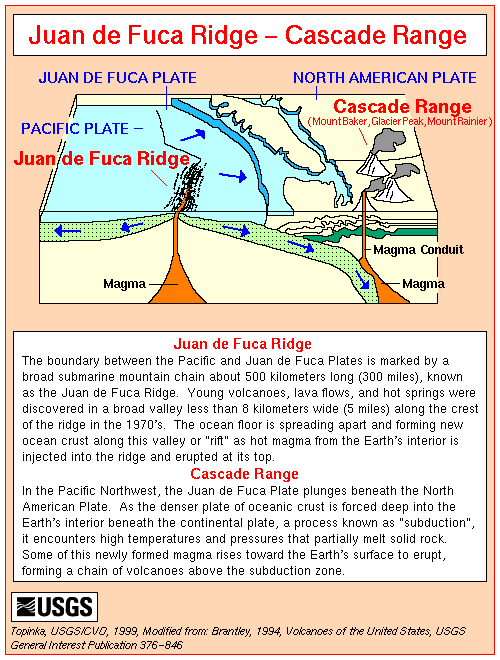
The Juan de Fuca microplate system is presently located between N40deg. and N52deg. latitude along the Pacific coast of the North American continent. This region is part of the "Ring of Fire", a circular lineament of volcanic activity which boarders the pacific margins. The "Ring of Fire" is generally associated with subduction volcanics, and, in the Pacific Northwest of the U. S., this arc-subduction volcanic complex is the Cascade Range.

Note the area of interest is enclosed by the gray box.
The History
The Farallon Plate is believed to have played a very important role
in the development of the western North American continent. The interaction
of the Farallon-North American plate boundary began in the Jurassic and
is still occurring today in the form of the Juan de Fuca microplate subduction
system. The original Farallon-North American plate boundary is clouded
in mystery and may have had several different characteristics over the
life-time of the boundary zone. Toward the end of the Farallon plate portions
of the Farallon plate were entirely subducted under the North American
plate and the Pacific-North American plate boundary began to dominate the
western U.S.
The Pacific plate has different characteristics and a different vector (tending NE related to North American plate motion) then the Farallon plate. The Pacific-North American plate boundary resulted in a transform convergence zone. The remnant of the Farallon which was not entirely subducted in the north of the Pacific-North American plate transform boundary (at a point named for the juncture of the three tectonic plates: Mendocino Triple Junction) was one solid continuous Juan de Fuca plate.

Note the Pacific-North American plate transform
boundary as the San Andreas Fault,
the Mendocino Triple Junction were the three
plates meet, and
the Juan de Fuca-North American plate subduction
boundary.
The Cascade volcanic range originated between 55 and 42Ma and has been
an active arc-subduction complex for 36Ma (Swanson, 1989). This development
marks the change of the terminating Farallon Plate into the Juan de Fuca
Plate. The Gorda Plate (the southern most of the three microplates) fractured
from the Juan de Fuca plate approximately 18 - 5Ma at the Blanco Fracture
Zone (Wood and Kienle, 1990). The Explorer plate (the northern most of
the three microplates) fractured from the Juan de Fuca plate approximately
4Ma at the Sovanco Fracture Zone (Wood and Kienle, 1990). Each plate acts
relatively autonomous of the other.
The Importance

The Juan de Fuca has all three types of dynamic plate boundaries occurring within a relatively small area.
The three types of dynamic plate boundaries are the convergent, divergent, and the transform boundaries. The Juan de Fuca microplate system consists of a subduction zone along the North American plate at both the Gorda and the Juan de Fuca plates. The system meets the Pacific plate along a divergent zone at the east most boundaries. This divergent zone is composed of three major sea mount ridges (the Gorda, Juan de Fuca, and the Explorer ridges) which feed both the Juan de Fuca microplates to the west and the Pacific plate to the east. The divergent zone also doubles as a transform zone at the extension of the San Andreas lateral motion along the Mendocino, Blanco, and Sovanco Fracture Zones.

Note the three types of dynamic plate boundaries
and their descriptions.
The location of all three types of dynamic plate margins in close proximity makes the Juan de Fuca microplate system the location of several unique geologic features.
For a more detailed discussion of the characteristics
of the Juan de Fuca microplate system
[click here]
Swanson, 1989, Cenozoic Volcanism in the Cascade Range and Columbia Plateau, Southern Washington, and Northernmost Oregon: AGU Field Trip Guidebook T106.
Brantley, 1994, Volcanoes of the U.S.: USGS General Interest Publication
Noson, Qamar, and Thorsen, 1988, Washington State Earthquake Hazards: Washington State Department of Natural Resources, Washington Division of Geology and Earth Resources Information Circular 85
Wood and Kienle, 1990 Volcanoes of North America: U.S. and Canada: Cambridge University Press
Fuis G. Tectonophysicis, 1998, West Margins of North America, a Synthesis of recent Seismic Transects
Duncan and Kulm, 1989, The Geology of North America Vol. N, The Eastern
Pacific Ocean and Hawaii: The Geological Society of America, 1989